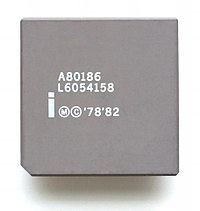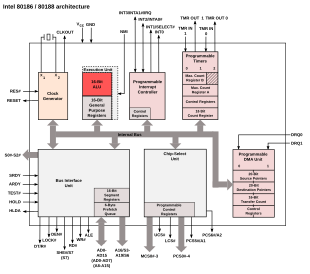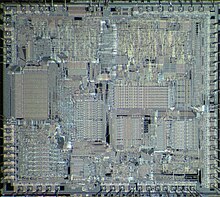 An Intel A80186 processor in a gray ceramic package | |
| General information | |
|---|---|
| Launched | January 1982 |
| Discontinued | September 28, 2007[1] |
| Common manufacturer | |
| Performance | |
| Max. CPU clock rate | 6 MHz to 25 MHz |
| FSB speeds | 6 MHz to 25 MHz |
| Data width | 16 bits |
| Address width | 20 bits |
| Architecture and classification | |
| Application | Desktop, Embedded |
| Technology node | 3 μm[3] to 1 μm[4] |
| Instruction set | x86-16 |
| Physical specifications | |
| Transistors |
|
| Co-processor | 8087 and later, 80C187 (for 80C186 only) |
| Package | |
| Socket | |
| Products, models, variants | |
| Variant | |
| History | |
| Predecessor | Intel 8088 |
| Successors | Intel 80386 (The 80286 was also introduced in early 1982, and thus contemporary with the 80186) |
| Support status | |
| Unsupported | |
The Intel 80186, also known as the iAPX 186,[5] or just 186, is a microprocessor and microcontroller introduced in 1982. It was based on the Intel 8086 and, like it, had a 16-bit external data bus multiplexed with a 20-bit address bus.


The 80186 series was designed to reduce the number of integrated circuits required. It included features such as clock generator, interrupt controller, timers, wait state generator, DMA channels, and external chip select lines. It was used in numerous embedded systems, as microcontrollers with external memory.
The initial clock rate of the 80186 was 6 MHz, but due to more hardware available for the microcode to use, especially for address calculation, many individual instructions completed in fewer clock cycles than on an 8086 at the same clock frequency. For instance, the common register+immediate addressing mode was significantly faster than on the 8086,[a] especially when a memory location was both (one of) the operand(s) and the destination. Multiply and divide also showed great improvement, being several times as fast as on the original 8086, and multi-bit shifts were done almost four times as quickly as in the 8086.
A few new instructions were introduced with the 80186 (referred to as the 8086-2 instruction set in some datasheets[citation needed]): enter/leave (replacing several instructions when handling stack frames), pusha/popa (push/pop all general registers), bound (check array index against bounds), and ins/outs (input/output of string). A useful immediate mode was added for the push, imul, and multi-bit shift instructions. These instructions were also included in the contemporary 80286 and in successor chips.[b]

The (redesigned) CMOS version, 80C186, introduced DRAM refresh, a power-save mode, and a direct interface to the 80C187 floating-point numeric coprocessor. Intel second-sourced this microprocessor to Fujitsu Limited around 1985.[6] Both packages for Intel 80186 version were available in 68-pin PLCC and PGA in sampling at third quarter of 1985.[7] The available 12.5 MHz Intel 80186-12 version using the 1.5 μm HMOS-III process for US$36 in quantities of 100.[8] The available 12.5 MHz Intel 80C186 version using the CHMOS III-E technology using approximately 90 mA under normal load and only 32 mA under power-save mode. It was available in 68-pin PLCC, CPGA, or CLCC package.[9] The military version of Intel M80C186 embedded controller was available in 10 and 12 MHz version. They met MIL-STD-883 Rev. C and MIL-STD-1553 bus application standards. The 12 MHz CHMOS version consumes approximately 100 mA. The available packages were 68-pin CPGA and CQFP. The 10 MHz M80C186 PGA version was available for US$378 in 100-unit quantities.[10] The available 80C186EB in fully static design for the application-specific standard product using the 1 μm CHMOS IV technology. They were available in 3- and 5-volt versions with 84-lead PLCC and 80-lead EIAJ QFP packaging. It was also available for US$16.95 in 1,000-unit quantities.[11] The Intel 80C186EC contains 4 DMA channels, 2 interrupt controllers, 22 I/O which control two serial channels, and 4 timers. This version was available for US$17.70 in quantites of 1,000 units. This microcontroller only available in 5-volt version. Both Intel 80C186EC and 80C186EA contains three different power-management modes, which has idle, powerdown and powersave. The 80C186EA has both 5- and 3-volt versions. The 80C186XL version was available up to 20 MHz, which is compatible with existing CMOS version of 80C186 that has 25% higher performance and 50% lower power consumption. This version used 1 μm CHMOS process technology. Both 80C186EA and 80C186XL were available for US$11.80 in quantities of 1,000 units.[12]
 An Intel R80C188XL20, an LCC variant of the 80188 processor. It has a ceramic heat spreader and gold plated contacts on the bottom. | |
| General information | |
|---|---|
| Launched | 1982 |
| Discontinued | September 2007[13] |
| Common manufacturer | |
| Performance | |
| Max. CPU clock rate | 6 MHz to 40 MHz |
| Data width | 8 bits |
| Address width | 20 bits |
| Architecture and classification | |
| Technology node | 3 μm[15] to 1 μm[16] |
| Instruction set | x86-16 |
| Physical specifications | |
| Transistors |
|
| Cores |
|
| Co-processor | Intel 80187 |
| Package | |
| Socket | |
| Products, models, variants | |
| Variant |
|
| History | |
| Predecessor | Intel 8088 |
| Successors | Intel 80386 (The 80286 was also introduced in early 1982, and thus contemporary with the 80186) |
The 80188 variant, with an 8-bit external data bus was also available; this made it less expensive to connect to peripherals. The 16-bit registers and the one megabyte address range were unchanged, however. It had a throughput of 1 million instructions per second.[17] Intel second sourced this microprocessor to Fujitsu Limited around 1985.[18] Both packages of Intel 80188 version were available in 68-pin PLCC and PGA in sampling at third quarter of 1985.[19] The available 80C188EB in fully static design for the application-specific standard product using the 1-micron CHMOS IV technology. They were available in 3- and 5-Volts version with 84-lead PLCC and 80-lead EIAJ QFP version. It was also available for US$15.15 in 1,000 unit quantities.[20]
The 80188 series was generally intended for embedded systems, as microcontrollers with external memory. Therefore, to reduce the number of chips required, it included features such as clock generator, interrupt controller, timers, wait state generator, DMA channels, and external chip select lines. While the N80188 was compatible with the 8087 numeric co-processor, the 80C188 was not. It did not have the ESC control codes integrated.
Because the integrated hardware included in the 80186 was incompatible with the support chips chosen by IBM for the 8088-based IBM PC released a few months earlier, the chip did not see wide success in the PC market. IBM chose the 80286 for its successor, the IBM PC/AT, released in autumn 1984. Most other PC-compatible manufactures followed.
Regardless, several notable personal computers used the 80186:
In addition to the above examples of stand-alone implementations of the 80186 for personal computers, there were at least two examples of "add-in" accelerator card implementations: the BBC Master 512, Acorn's plug-in for the BBC Master range of computers containing an 80186–10 with 512 KB of RAM, and the Orchid Technology PC Turbo 186,[21] released in 1985. It was intended for use with the original Intel 8088-based IBM PC (Model 5150).
The Intel 80186 and 80188 are often embedded in electronic devices that are not primarily computers. For example:
On March 30, 2006, Intel announced that production of the 80186 and 80188, along with the production of other processor models such as the 80386 and 80486, would cease at the end of September 2007.[26][27] Pin- and instruction-compatible replacements might still be manufactured by various third-party sources,[28] and FPGA versions are publicly available.[29]